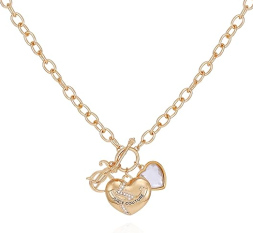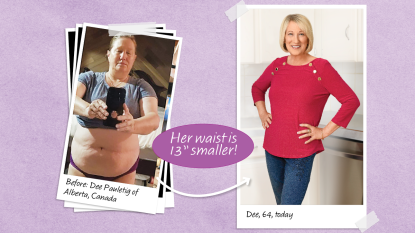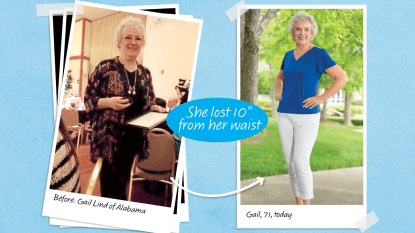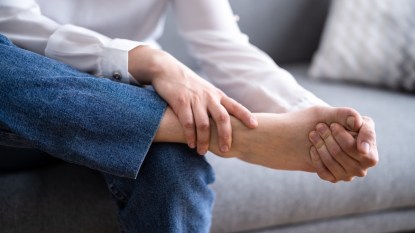Improve Kidney Function Naturally To Dramatically Decrease All-Body Bloat + Boost Energy and Heart Health, Say MDs
7 easy ways to get healthier and look slimmer — fast!

Is your face looking a bit puffier these days? Or maybe you’ve noticed that your rings and shoes feel tighter, or that your energy often plummets mid-afternoon. If so, sluggish kidneys could be to blame. While everything from dehydration to high blood pressure can strain these hardworking organs, help is here! Read on to discover how to improve kidney function naturally — the easy way!
Understanding how your kidneys work
We don’t often give our kidneys a second thought. But the organs, positioned in the back of your abdomen just below your ribcage, play a crucial role in keeping you healthy. In fact, they’re as important to your health as your heart and lungs, notes Fred Pescatore, MD. “Your kidneys serve as your body’s main filtration system,” he explains. “They filter waste products and toxins from the bloodstream so they can be excreted via urine,” he explains. Indeed, a report in Integrative Medicine: A Clinician’s Journal reveals your kidneys filter your body’s blood supply a whopping 60 times per day! And in doing so, they remove metabolic byproducts such as ammonia, urea, uric acid, creatinine, as well as heavy metals and other toxic substances.
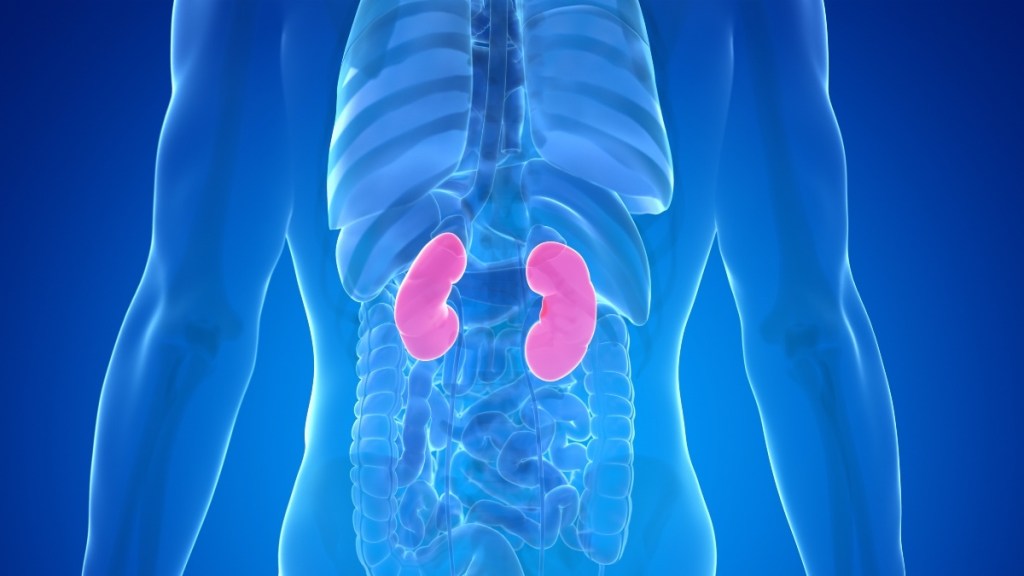
The benefits of naturally improving kidney function
In addition to filtering out wastes and toxins, your kidneys play other important roles in keeping your body healthy. Here are some of the total-benefits you can expect when you improve kidney function naturally.
1. Balanced blood pressure
One way your kidneys ward off high blood pressure? By keeping the body’s sodium levels in balance. “This prevents the excess that can cause blood pressure to climb,” Dr. Pescatore explains. Plus, the organs produce nitric oxide, a substance that safeguards against high blood pressure by helping blood vessels relax and open. And kidneys also release an enzyme known as renin, he adds. That’s key, since renin sets off a series of chemical reactions in the body that safeguards against dangerous dips in blood pressure. An added heart-health benefit: Findings in the journal Circulation suggest that when the organs are in shape, your risk of heart disease drops by up to 69%.
2. Strong muscles
By keeping sodium and other electrolyte minerals such as calcium, potassium and phosphate in balance, kidneys also optimize fluid levels in the body. And as researchers reporting in the journal Orthopedic Nursing note, proper levels of electrolytes protect muscles against weakness and fatigue. (Click through to see the best potassium-rich foods.)
3. Steady energy
But that’s not all: Kidneys produce a hormone called erythropoietin. The hormone stimulates production of red blood cells, which ensure delivery of energizing oxygen throughout the body. And since vitamin D is converted into its active form by the kidneys, it’s a boon for your body in more ways than one. Says Dr. Pescatore, “Vitamin D has a whole host of benefits. It’s critical for bone health, proper function of the lungs and immune system, cancer prevention and more.” For more details on the benefits of vitamin D, check out the video below.
Common reasons kidneys become sluggish
Kidney slowdowns aren’t unusual, which is why it’s no surprise so many of us want to improve our kidney function naturally. Here are the top triggers that can cause sluggishness.
1. Getting older
One of the biggest reasons kidney function may falter over time is age. A study in the journal PLoS One determined that kidney function drops by 1.3% per year. It may not sound like much, but it translates to a decline of up to 78% between age 18 and age 50.
2. Dehydration
If you’re like us, you often grab your reusable water bottle in the morning with every intention of staying hydrated. But go-go-go days cause many of us to forgot to down ample H2O. That’s a problem when it comes to kidney function. Findings in the journal Nephrology reveal that skimping on fluids raises risk of kidney problems by 50%. The reason: Dehydration causes urine to concentrate. “This increases levels of substances such as urea and albumin that can damage the kidneys,” notes Dr. Pescatore.
Plus, dehydration is a top cause of kidney stones, say researchers reporting in the Turkish Journal of Urology. And kidney stones are more than just painful, they can overtax the organs. In a Clinical Journal of the American Society of Nephrology investigation, people prone to stones were 51% more likely to show evidence of impaired kidney function than their stone-free counterparts. (Click through to learn more about electrolyte waters like Liquid IV and how they can optimize hydration and help you lose weight.)
3. Certain bacterial infections
An all-too-common type of urinary tract infection called pyelonephritis that spreads to the kidneys can produce inflammation and scarring in the organs. And in a study published in the journal PLoS ONE, pyelonephritis increased risk of acute kidney injury (AKI) — a condition marked by significant impairments in function — by 163%.
Surprisingly, gum infections can also harm the kidneys, according to another PLoS ONE study. Researchers determined that the inflammation caused by periodontitis, a severe form of gum infection, increased the odds of experiencing kidney failure by up to 35%.
4. High blood pressure
Elevated blood pressure puts added stress on blood vessels in the kidneys, causing the vessels to deteriorate over time. This reduces blood flow to the kidneys and impedes their ability to work properly. The proof: Research in Hypertension suggest that a 10-point climb in diastolic blood pressure increases the risk of chronic kidney disease (CKD), marked by permanent kidney damage that worsens over time, by 37%. And in the same study, a 5-point increase in systolic blood pressure increased CKD risk by 19%. (Click through for 20 easy hacks to lower blood pressure.) For more information on CKD, check out the video below.
5. High blood sugar
An excess of glucose in the bloodstream, which can be caused by diabetes, a diet high in sugary foods, resistance to the blood sugar balancing hormone insulin and lack of exercise, can also hamper kidney function over time. Experts reporting in the journal Life explain that a buildup of blood sugar triggers inflammation that harms glomeruli, tiny clusters of blood vessels that serve as key filtering bodies in the organ. And as authors of a PLoS ONE study point out, diabetes is the leading cause of CKD.
6. Common pain relievers
Nearly everyone reaches for pain-relieving pills from time to time. But overdoing NSAIDs (nonsteroidal anti-inflammatory drugs such as naproxen and ibuprofen) can prove toxic to the kidneys. A report in the journal Kidney360 found taking NSAIDs at doses of 200 mg. or more daily triggered significant declines in kidney function within 4 years.
As for acetaminophen, a study in the journal Clinical Epidemiology indicates the pain reliever is safer than NSAIDs for kidneys. But again, overuse can prove problematic. According to a New England Journal of Medicine study, taking 366 or more acetaminophen pills per year upped the odds of kidney failure by 110%. (Click through to learn how ginger shots can ease pain naturally.)
How to improve kidney function naturally
Despite the threats that kidneys face, preventing — and even reversing — problems is easy. Here, the simple, science-backed strategies that improve kidney function naturally.
1. Fill up on fluids
Drinking plenty of water deters the dehydration that can put a damper on kidney function. And in an American Journal of Nephrology study, researchers found staying well-hydrated cut the risk of developing CKD by 60%. To keep the organs operating at their peak, Dr. Pescatore recommends sipping half your body weight in ounces of water (that’s 75 oz., or about nine 8-oz. glasses, for someone who weighs 150 pounds) per day. An easy way to tell if you’re hitting the kidney-friendly mark: Your urine will be pale yellow rather than dark or neon-bright, he says. (A glass of cold water also tones your vagus nerve to thwart chronic stress.)
2. Make a soda swap
Trading two daily colas for clearer carbonated drinks like seltzers reduces the risk of kidney slowdowns and stones by 50%, findings in Epidemiology suggest. Researchers say the phosphoric acid found in colas strains the kidney and contributes to stone formation. For a refreshing sip that eliminates the risks, mix equal parts sparkling water and pomegranate juice. Research in Cellular and Molecular Biology reveals the juice’s polyphenol compounds improve kidney cells’ ability to withstand damage that can spur sluggishness.

3. Chow down on chili
Eating 1⁄2 cup of legumes like kidney beans or navy beans daily slashes your odds of kidney sluggishness by 50%. So say researchers reporting in the British Journal of Nutrition, who found the soluble fiber in legumes protects against the blood sugar spikes that can harm the organs over time. Other foods that deliver a kidney-friendly fiber boost: chickpeas, green peas and lentils. (Click through to our sister publication to see how much fiber you need to lose weight.)
4. Nosh on nuts
Pistachios, cashews, almonds and other nuts aren’t just a tasty, filling snack. A study in the American Journal of Nephrology suggests eating a handful of nuts one to six times weekly curbs the odds of developing CKD by 37%. Study authors explain nuts are high in unsaturated fatty acids, magnesium and potassium. That’s key, since the nutrients defend against kidney- draining blood pressure elevations.
5. Try the ‘golden spice’
Turmeric, also known as the golden spice, makes for a delicious addition to eggs, dips, veggies and even tuna salad. And it’s a treat for your kidneys, too! Research in the Scandinavian Journal of Urology and Nephrology suggests enjoying 3⁄4 tsp. of the spice daily improves kidney function by 46% in two months. The reason: The curcumin that gives turmeric its golden hue defends kidneys against harmful molecules called free radicals.
Also smart: Taking capsule-form curcumin in place of kidney-taxing OTC pain relievers. According to Eva Selhub, MD author of Your Health Destiny, curcumin calms inflammation to ease pain. And as rheumatologist Scott Zashin, MD, author of Arthritis Without Pain, adds, curcumin helps muscles recover from stress. He also recommends the herb Boswellia to ease soreness. A study in Therapeutic Advances in Musculoskeletal Disease found curcumin and Boswellia work together to tame inflammation and pain. Try: Terry Naturally CuraMed Acute Pain Relief (Buy from iHerb.com, $41.56).
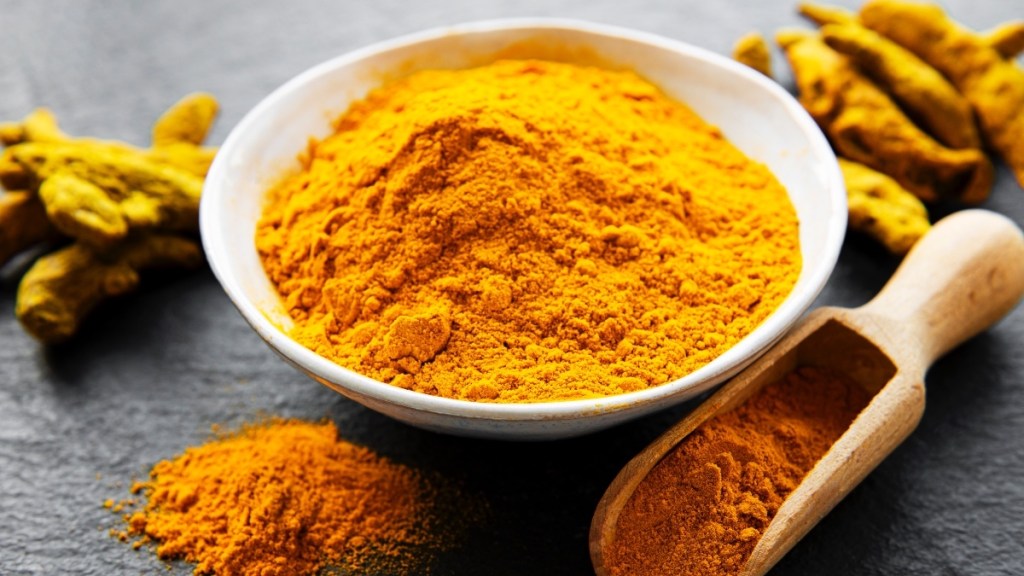
6. Head out for a stroll
Scientists reporting in the Journal of the American Society of Nephrology found that folks who engaged in enjoyable activities (think walking, biking, swimming or playing pickleball) for 30 minutes daily had kidneys that worked 36% better than their less-active counterparts. And in a separate study that appeared in the journal, walking for a total of 3 hours weekly lowered kidney stone risk by 31%. Even brief bouts of exercise boost blood flow to the kidneys while directing stone-forming calcium to bones so it doesn’t accumulate in the organs.
7. Consider these supplements
When it comes to supplements that improve kidney function naturally, two stand head and shoulders above the rest. The first is resveratrol, a compound found in purple grapes and red wine. A study in Renal Failure found supplementing with resveratrol daily increases kidney function by 65% in 12 weeks — and the benefits begin within the first week. Study authors note that resveratrol tames kidney-damaging inflammation. Plus, it protects against increases in blood sugar that can cause the organs to falter. For best benefits, take trans-resveratrol, the highly-absorbable form of the compound used in the study. One to try: Naomi Organic Resveratrol (Buy from NaomiW.com, $35).
The second superstar supplement is the pine bark extract known as Pycnogenol (or maritime pine). Dr. Pescatore also recommends taking 150 mg. of Pycnogenol daily. A study in the journal Panminverva Medica found doing so boosted kidney function by 53% in six months. Study authors say Pycnogenol increases blood flow to the kidneys while lowering damaging inflammation. One to try: Swanson Ultra Pycnogenol Super Strength (Buy from Swansonvitamins.com, $32.39). (Click through to learn how Pycnogenol also soothes dry mouth.)
Read on for more ways to safeguard your kidney health:
5 Natural Remedies That’ll Drop Your Risk of Kidney Stones Up to 87 Percent
Drinking This Popular Beverage Regularly Could Lower Your Risk of Kidney Stones
Taking Too Much of This Common Vitamin Could Damage Your Thyroid and Cause Kidney Stones

